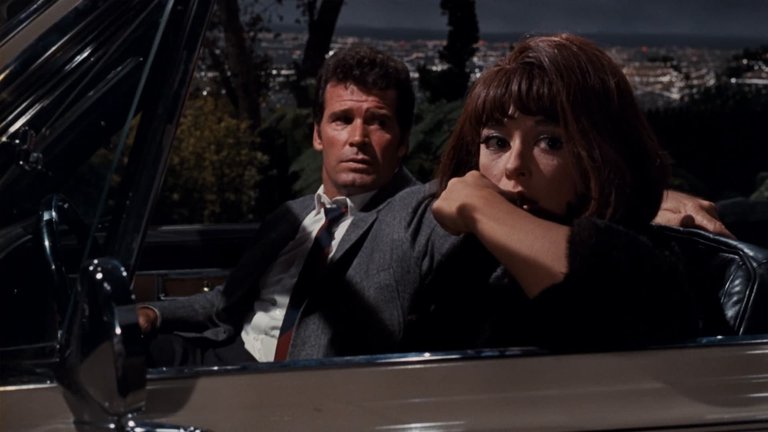
Certain films achieve notoriety for reasons that defy conventional acclaim. Such is the case with Marlowe (1969), a middling crime caper directed by Paul Bogart, which has secured its footnote in cinematic history not through artistic merit, but via an incidental detail its creators likely dismissed as trivial: the presence of Bruce Lee in a minor, racially caricatured role. This otherwise forgettable entry in the Philip Marlowe canon—a derivative neo-noir overshadowed by superior adaptations—is chiefly remembered today for featuring Lee’s early Hollywood cameo, a casting choice that now reads as both prescient and deeply problematic . The irony is palpable: a film otherwise looking like na uninspired television-like film owes its cultural half-life to a martial arts icon whose star would soon eclipse the project entirely.
Based on Raymond Chandler’s 1949 novel The Little Sister, the film inherits the labyrinthine plotting and moral ambiguity emblematic of the author’s hardboiled detective fiction. Chandler’s works, notably The Big Sleep and Farewell, My Lovely, had already been immortalised as film noir classics, their shadowy aesthetics and morally compromised characters defining the genre. Yet Marlowe struggles to translate Chandler’s layered cynicism to the screen. The source material’s convoluted narrative—centred on blackmail, familial betrayal, and Hollywood corruption—is rendered even more opaque by Stirling Silliphant’s script, which truncates key exposition (e.g., omitting Orfamay’s initial hiring of Marlowe) and prioritises brisk pacing over coherence . While Chandler’s novels thrived on ambiguity, the film’s haphazard editing and narrative gaps leave audiences adrift, a flaw exacerbated by Bogart’s pedestrian direction .
The plot, faithful in outline to Chandler’s novel, follows Los Angeles private eye Philip Marlowe (played by James Garner) as he investigates the disappearance of Orrin Quest, brother to the seemingly innocent Orfamay (played by Sharon Farrell). His inquiry spirals into a web of ice-pick murders, incriminating photographs of television star Mavis Wald (played by Gayle Hunnicutt) with mobster Sonny Steelgrave (played by H.M. Wynant), and a blackmail scheme implicating Orrin. Marlowe’s dogged pursuit pits him against Steelgrave’s thugs—including Bruce Lee’s Winslow Wong—and the irate Lt. French (played by Carroll O’Connor), while allies like studio executive Crowell (played by William Daniels) and dancer Dolores Gonzales (played by Rita Moreno) blur the line between accomplice and adversary .
Chandler’s signature themes—the rot beneath Hollywood’s glamour, the futility of moral certitude—are gestured toward but never fully realised. The blackmail plot, tied to Wald’s career and Steelgrave’s Brooklyn syndicate past, culminates in a rushed denouement where familial bonds (Orfamay, Orrin, and Wald are siblings) and Dolores’ jealousy drive the bloodshed. Yet the film’s insistence on speed over substance reduces these twists to narrative noise, leaving viewers to marvel at the audacity of a script that expects them to keep pace .
Silliphant’s adaptation modernises Chandler’s 1940s Los Angeles, trading noir’s chiaroscuro for the garish Technicolor of late-1960s California. The updated setting—replete with penthouse parties, psychedelic drugs, and a fleeting hippie cameo—reflects Hollywood’s pivot toward “hip” contemporaneity, yet the film’s visual language remains curiously inert. Bogart’s direction, visually flat, fails to evoke either the grit of Chandler’s LA or the psychedelic vibrancy of the era. Instead, the production design leans into exploitation tropes: the film opens with salacious photographs of Wald and Steelgrave and concludes with Rita Moreno’s semi-nude burlesque routine, gestures toward risqué content that feel more cynical than innovative .
This tonal dissonance extends to the script’s half-hearted nods to counterculture. While Chandler’s novel critiqued Hollywood’s venality, the film reduces his social commentary to set dressing, its glossy veneer clashing with the source material’s cynicism. The result is a murder mystery that resembles a “workmanlike” TV episode, its aesthetic neither embracing noir’s legacy nor forging a new identity .
James Garner’s interpretation of Marlowe epitomises the film’s identity crisis. Eschewing Humphrey Bogart’s world-weary gravitas, Garner plays the detective as a smirking, roguish charmer—more 1960s playboy than hardboiled cynic. While his performance has defenders who argue it aligns with Chandler’s early novels , the lack of emotional depth undermines the character’s moral complexity. Garner’s Marlowe feels less like a man navigating a corrupt world than a TV-ready hero quipping his way through set pieces—a precursor to his later role in The Rockford Files .
The supporting cast fares unevenly. Carroll O’Connor’s Lt. French veers into camp, his exasperation with Marlowe bordering on hysterical . Rita Moreno injects pathos into Dolores, particularly in her haunting final scene, but the role remains underwritten . Only Bruce Lee’s Wong lingers in memory, albeit for the wrong reasons.
Lee’s casting as Winslow Wong—a karate-chopping thug who terrorises Marlowe—exemplifies Hollywood’s reductive treatment of Asian actors in this era. His two scenes, while showcasing his physical prowess, reduce him to a racial caricature: a silent, hyperviolent “Oriental” whose humiliation (he falls to his death after Marlowe taunts him as “gay”) feels grotesquely at odds with Lee’s later iconicity . The film’s legacy is irrevocably stained by this regressive portrayal, a stark reminder of the industry’s entrenched biases.
Marlowe’s reputation suffered further with the release of bolder Chandler adaptations. Robert Altman’s The Long Goodbye (1973) reimagined Marlowe as a shambling anachronism in 1970s LA, while Dick Richards’ Farewell, My Lovely (1975) delivered a stylistically faithful noir revival. Compared to these, Bogart’s film seems doubly archaic: neither a nostalgic homage nor a daring reinvention, but a limp hybrid of old and new .
Marlowe endures not as a triumph of craft, but as a curiosity—a film whose infamy rests on Bruce Lee’s stigmatised role and its failure to honour Chandler’s legacy. For devotees of detective cinema, it offers fleeting pleasures: Garner’s charm, Moreno’s magnetism, and Lee’s nascent star power. Yet these fragments cannot salvage a work that, like its ill-fated thug Winslow Wong, ultimately plunges into oblivion.
RATING: 5/10 (++)
Blog in Croatian https://draxblog.com
Blog in English https://draxreview.wordpress.com/
InLeo blog https://inleo.io/@drax.leo
Hiveonboard: https://hiveonboard.com?ref=drax
InLeo: https://inleo.io/signup?referral=drax.leo
Rising Star game: https://www.risingstargame.com?referrer=drax
1Inch: https://1inch.exchange/#/r/0x83823d8CCB74F828148258BB4457642124b1328e
BTC donations: 1EWxiMiP6iiG9rger3NuUSd6HByaxQWafG
ETH donations: 0xB305F144323b99e6f8b1d66f5D7DE78B498C32A7
BCH donations: qpvxw0jax79lhmvlgcldkzpqanf03r9cjv8y6gtmk9
Posted Using INLEO

